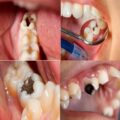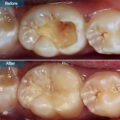Tooth pain can be excruciating, disrupting daily life and causing immense discomfort. Desperate for relief, individuals may come across claims of quick-fix solutions promising to permanently alleviate tooth pain in a matter of seconds. One such claim suggests the ability to “kill” the tooth pain nerve in just three seconds.
But is there any truth to this assertion, or is it merely a myth? Let’s delve into the science behind tooth pain and explore whether such rapid and permanent relief is achievable.
Understanding Tooth Pain
Tooth pain, also known as dental pain or odontalgia, typically stems from underlying dental issues such as cavities, dental infections, gum disease, or tooth trauma. The pain occurs when nerve endings within the tooth pulp become irritated or damaged, sending signals of discomfort to the brain. This mechanism serves as a warning sign of potential dental problems that require attention from a dentist.
Debunking the Myth
The notion of permanently killing the tooth pain nerve in three seconds is a misconception that lacks scientific validity. Here’s why:
- Complexity of Dental Anatomy: The tooth is a complex structure with multiple layers, including enamel, dentin, pulp, and nerve tissues. Achieving instant and permanent relief from tooth pain would require targeting and altering the nerve tissue deep within the tooth pulp. However, accessing and modifying this delicate structure in a matter of seconds without causing further damage is virtually impossible.
- Lack of Safe and Effective Methods: While various dental procedures, such as root canal therapy, aim to address tooth pain by removing damaged nerve tissue, these treatments require careful planning, precision dental intruments, and time to ensure success. Attempting to “kill” the tooth pain nerve through quick and improvised methods can lead to irreversible harm, including infection, nerve damage, and loss of the tooth.
- Importance of Professional Dental Care: Effective management of tooth pain necessitates professional evaluation and treatment by a qualified dentist. Dentists employ evidence-based approaches to diagnose and address the underlying cause of tooth pain, whether it be through restorative procedures, endodontic therapy, or periodontal treatments. Relying on unproven and potentially harmful remedies can exacerbate dental problems and compromise oral health.
Alternative Strategies for Tooth Pain Relief
While the immediate and permanent elimination of tooth pain may not be feasible through quick-fix methods, there are several safe and effective strategies for managing tooth pain and promoting oral comfort. These approaches encompass both temporary relief measures and long-term preventive strategies aimed at addressing the underlying causes of tooth pain. By incorporating these strategies into their oral care routine, individuals can alleviate discomfort and maintain optimal dental health. Let’s explore these alternative methods in more detail:
- Over-the-Counter Pain Relief: Non-prescription pain relievers, such as ibuprofen (Advil, Motrin) or acetaminophen (Tylenol), are commonly used to alleviate mild to moderate tooth pain. These medications work by reducing inflammation and blocking pain signals to provide temporary relief. It is essential to follow the recommended dosage instructions provided on the packaging and consult with a healthcare professional if the pain persists or worsens. Additionally, individuals should be cautious when using over-the-counter pain relievers, especially if they have underlying medical conditions or are taking other medications, to avoid potential adverse effects.
- Dental Home Remedies: Several home remedies can offer temporary relief from tooth pain and discomfort. While these remedies may not address the underlying cause of the pain, they can provide symptomatic relief until professional dental treatment is sought. Some common dental home remedies include:
- Rinsing with warm salt water: Salt water can help reduce inflammation and kill bacteria in the mouth, providing temporary relief from tooth pain and discomfort. To prepare a salt water rinse, dissolve half a teaspoon of salt in a glass of warm water and swish it around in the mouth for 30 seconds to a minute before spitting it out.
- Applying a cold compress: A cold compress or ice pack applied to the outside of the cheek can help numb the area and reduce swelling, providing temporary relief from tooth pain. Wrap the ice pack in a cloth or towel and apply it to the affected area for 15-20 minutes at a time, several times a day.
- Using clove oil: Clove oil contains eugenol, a natural anesthetic and antiseptic that can help numb the area and reduce pain. Apply a small amount of clove oil to a cotton ball or swab and gently dab it onto the painful tooth or gum area. Be careful not to swallow the clove oil, as it can cause irritation to the digestive tract.
While these dental home remedies can offer temporary relief from tooth pain, they should complement rather than substitute professional dental care. It is essential to seek prompt evaluation and treatment from a dentist to address the underlying cause of the pain effectively.
- Professional Dental Treatment: Seeking professional dental evaluation and treatment is crucial for addressing the root cause of tooth pain and restoring oral health. Depending on the diagnosis, the dentist may recommend various procedures to alleviate pain and promote healing. Some common dental treatments for tooth pain include:
- Dental fillings: If tooth pain is caused by a cavity or tooth decay, the dentist may recommend placing a dental filling to restore the tooth’s structure and function. Dental fillings can help alleviate pain and prevent further decay.
- Root canal therapy: If the tooth pain is caused by infection or inflammation of the tooth pulp, the dentist may recommend root canal therapy. During this procedure, the infected or damaged pulp tissue is removed, and the root canal is cleaned, disinfected, and sealed to prevent reinfection. Root canal therapy can effectively alleviate tooth pain and save the tooth from extraction.
- Tooth extraction: In cases where the tooth is severely damaged or infected and cannot be saved with other treatments, the dentist may recommend tooth extraction. Tooth extraction involves removing the affected tooth from the mouth to alleviate pain and prevent further complications. After tooth extraction, the dentist may recommend options for tooth replacement, such as dental implants, bridges, or dentures.
- Gum disease treatment: If tooth pain is caused by gum disease or periodontal infection, the dentist may recommend periodontal treatment to restore gum health and alleviate pain. This may include professional dental cleaning, scaling and root planing, antibiotic therapy, or surgical procedures to treat advanced gum disease.
- Preventive Oral Care: Practicing good oral hygiene and adopting preventive oral care habits can help prevent tooth pain and dental problems in the long term. Some essential preventive measures include:
- Regular brushing: Brush your teeth at least twice a day using fluoride toothpaste and a soft-bristled toothbrush. Brushing removes plaque and food particles from the teeth and gums, preventing tooth decay and gum disease.
- Flossing: Floss your teeth once a day to remove plaque and debris from between the teeth and along the gumline. Flossing helps prevent cavities, gum disease, and tooth pain caused by dental infections.
- Dental check-ups: Schedule regular dental check-ups and cleanings with your dentist every six months or as recommended. Dental exams allow the dentist to detect and treat dental problems early, preventing tooth pain and other complications.
- Healthy diet: Eat a balanced diet rich in fruits, vegetables, whole grains, and lean proteins to support overall oral and dental health. Limit sugary foods and drinks, as they can contribute to tooth decay and gum disease.
- Avoiding tobacco products: Avoid smoking and using tobacco products, as they can increase the risk of gum disease, tooth decay, and oral cancer. Quitting smoking can improve oral health and reduce the risk of tooth pain and other dental problems.
By incorporating these preventive oral care habits into your daily routine, you can maintain optimal oral health and reduce the risk of tooth pain and dental problems in the future.
Conclusion
While the idea of permanently eliminating tooth pain in three seconds may sound appealing, it is a myth unsupported by scientific evidence. Tooth pain is a complex symptom that requires professional evaluation and treatment to address the underlying cause effectively. However, there are several safe and effective strategies for managing tooth pain and promoting oral comfort, including over-the-counter pain relief, dental home remedies, professional dental treatment, and preventive oral care. By seeking prompt dental care, adopting good oral hygiene habits, and prioritizing preventive measures, individuals can alleviate tooth pain, maintain optimal oral health, and enjoy a healthy smile for years to come.





